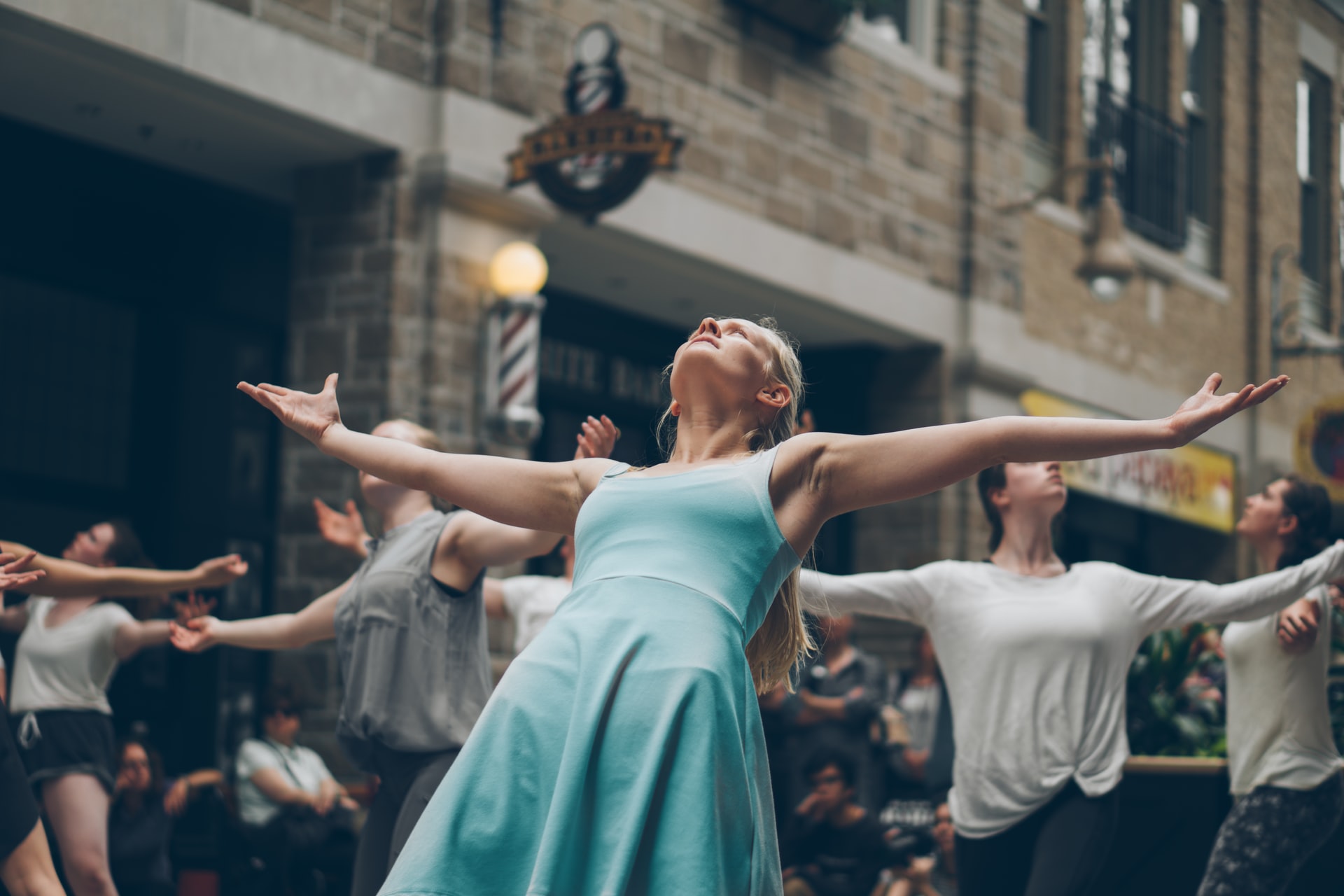Drama.
An excitable word that conjures a heightened state of emotion. For some, it means losing their cool. For others, every conversation ends in a shouting match and phones are thrown. Some might even go for the nuclear option when they should just walk away. We love… No, we lust for drama. We crave it — need it. Hell, we thrive on it.
Even the earliest cave people gathered around their newly minted fire to pour steaming hot tea over the coals, “Can you believe what Karl did today at the watering hole? What an idiot!”
Yes, we love drama — but that’s not really how life works. We’re bombarded daily by a thousand micro-aggressions passively spitting in our faces with a smile. It could be how your mother-in-law sneers at you, or when the bartender serves everyone around you despite making repeated eye contact, or even the lady who cuts you off in line because clearly you weren’t standing there.
For actors to transform into their characters, they need to think like them, embody them. Filmmaking is a collaborative endeavor. Every member of the cast and crew should be entrusted to deliver expertise to their role on set. They’re professionals who have studied and practiced their craft for years — there’s a reason why they were hired.
Just as the Director of Photography is trusted to know how to light a shot, the actor needs space to do their thing. I asked an actor once what he looks for in a screenplay. He told me that he appreciates when it’s clear that the writer trusts the actors to make creative decisions without feeling dictated by the page. This is especially the case when it comes to conveying a character’s emotional state through descriptions, rather than actions.
When a writer gets bogged down in describing every single facial expression or gesture, it can become exhausting to read. That is to say, unless you have a reason for it. Does your character have a nervous tic? Do they habitually chew their nails when they’re anxious? Details like this can add depth to your character, so don’t avoid them entirely. Every detail needs a purpose.
How you achieve that is entirely up to your style as a writer. As you’ll see in the examples below, these action lines and descriptions strike at the heart of the character’s internal emotional state without getting snagged on unnecessary physical expressions or traits. Some flow subtly, others strike a defining chord, and yet others are pure poetry.
Let’s take a look at how some incredible screenwriters were able to tell an entire story with a single expression.
Gone Girl – Gillian Flynn

In this scene, Nick has just spoken to the media about the disappearance of his wife. The detectives, the public, and the audience are all studying Nick’s every move — waiting for him to slip up. That’s why this little smile carries so much weight.
The word choice of smarmy elicits such a visceral response from the reader in the same way the screech of nails on a chalkboard sends a shiver down our collective spines. It’s a word that perfectly embodies its intent. You can visualize that smile. Add that he’s overly charming and oily — not only does the media eat it up, but so does the reader.
These kind of descriptions lead the reader towards the bait. They want to believe Nick. They want him to be a good person, but all the evidence is proving otherwise. He’s annoyed, not devastated like the Elliots. He smiles when he shouldn’t. Isn’t helpful to investigators. A collection of small little tells can add up and flip a person’s mind from believing someone’s innocent to a suspect.
Sometimes all it takes is a single word.
Mare of Easttown – Brad Ingelsby
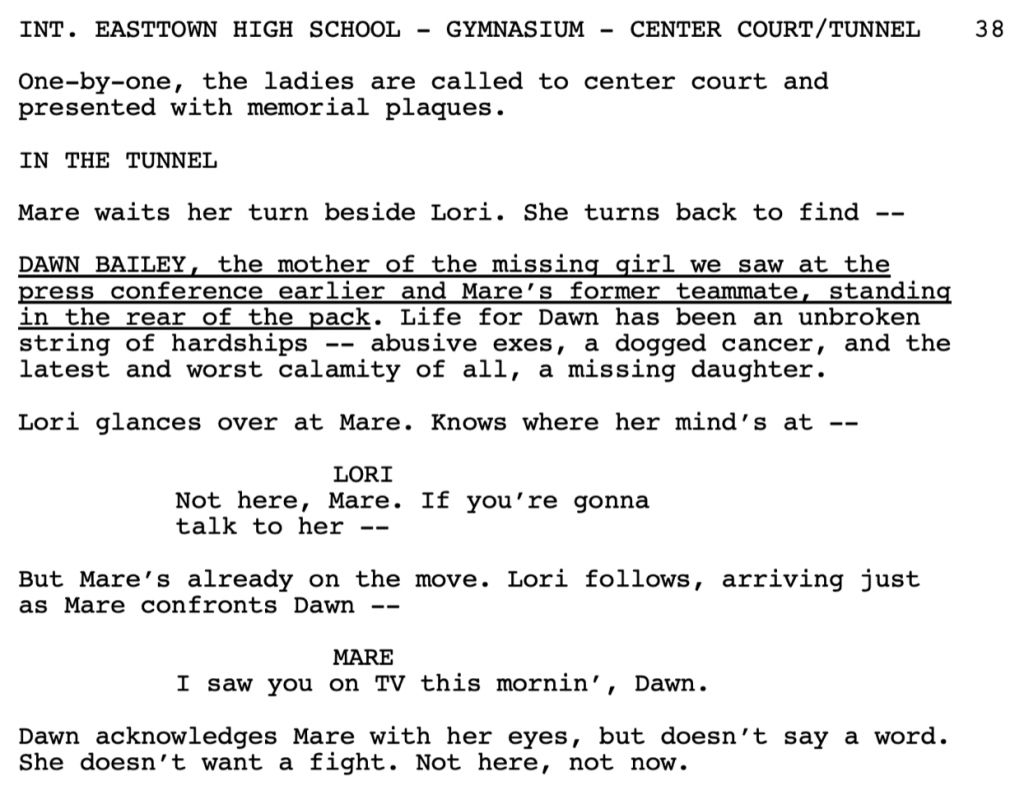
This scene is a perfect example of how a writer can layer backstory into the action while heightening drama instead of slowing the action down in order to explain it.
The women are about to be honored for their high school endeavors — a seemingly pinnacle moment in all these women’s lives. They’re far from their primes, and in the midst of what is supposed to be a joyous occasion, we see years of private tension and pain nearly boil over into a very public arena. As an audience, we’re teetering along the edge of sheer catastrophe.
The very sight of Dawn springs Mare into action. When Lori glances over to Mare, Ingelsby interrupts both the action and dialogue lines with her movement. When Dawn acknowledges Mare with only her eyes, you’re given a glimpse into her thought process.
The added, “She doesn’t want a fight. Not here, not now,” makes you think she wants to avoid a blow up in front of the whole town, but she’s not ready to back down from her fight to find her daughter. That last line builds audience anticipation by promising more, and we’re ready for it.
Nomadland – Chloé Zhao
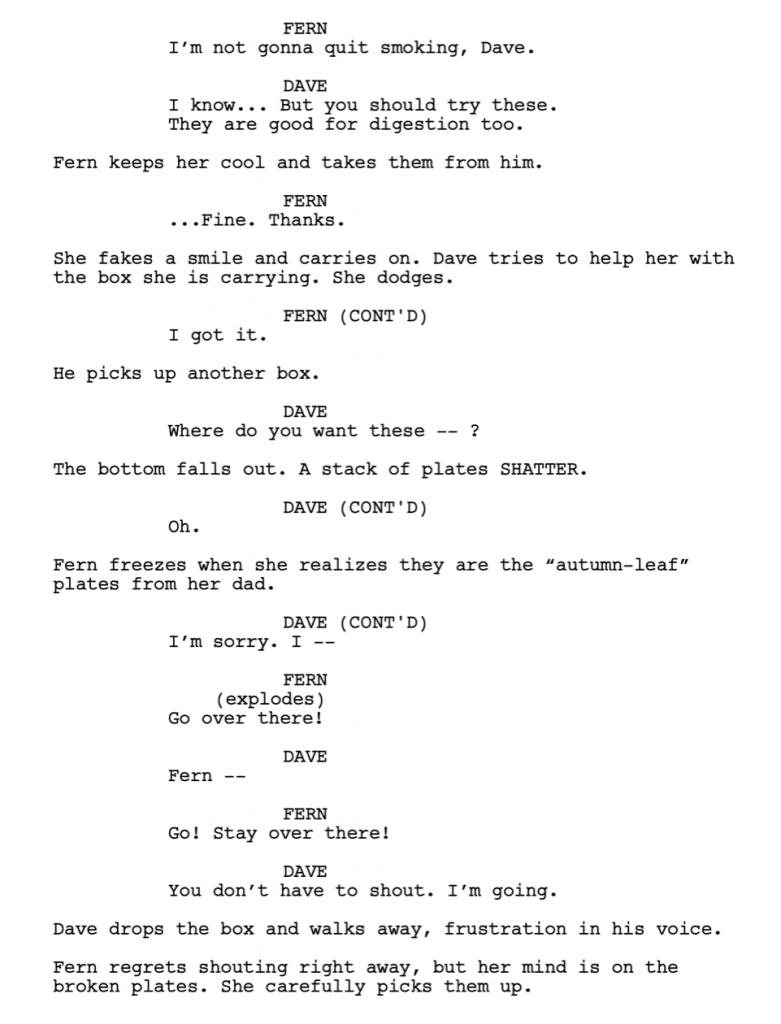
At this point of the screenplay, Fern’s dear friend has just left for greener pastures, so she’s dealing with grief the only way she knows how — keeping busy. She’s a proud and stubborn woman deep in a personal task when Dave visits. He offers her an alternative to smoking, which she begrudgingly accepts just to rid her of him. Honestly, she just wants to be left alone to sort through her things.
But Dave persists, and we see Fern’s patience wane until he inserts himself into his affairs and ends up breaking a precious heirloom. Fern doesn’t have many possessions, so she holds dear the things she does have.
Losing her temper goes against her nature, she holds her friends in high esteem. Zhao does an incredible job of showing the duality of one’s emotional turmoil when she notes that Fern, “regrets shouting right away, but her mind is on the broken plates.”
Beasts of the Southern Wild – Lucy Alibar and Benh Zeitlin
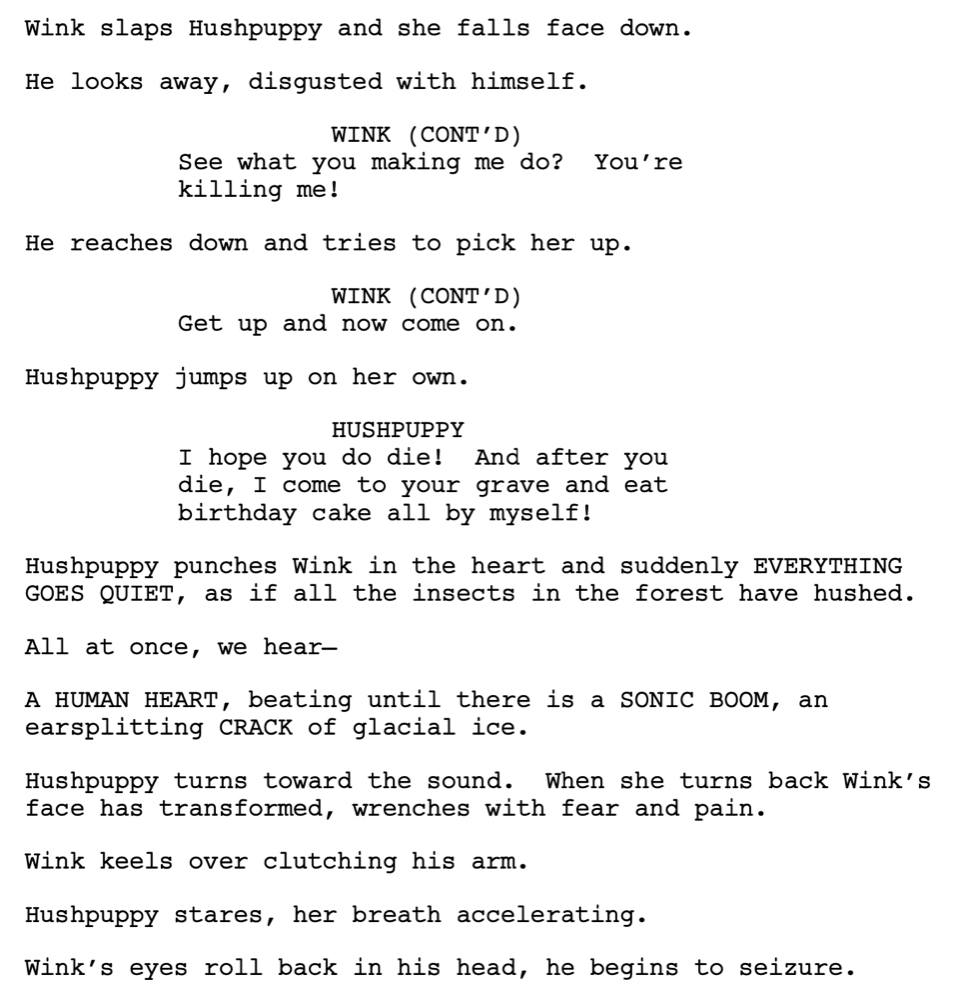
In this scene from Beasts of the Southern Wild, Wink has just returned from a stint in the hospital. From his description it’s clear that he checked out himself. His daughter, Hushpuppy, has been surviving on her own. Happy upon his arrival, Hushpuppy is dismissed as if he were never gone. She lashes out by turning up the stove, causing a gas explosion.
Wink nearly dies trying to save Hushpuppy, who runs out of the burning trailer on her own accord. He had just chased her down. In an attempt to control her, he hits her. When she punches him in the heart, we see and hear the effects — an earth shattering event that’ll transform her world.
It’s never explicitly stated that Wink has a heart attack and dies. We see it unfold on the page step by step, with just enough description to clearly illustrate what is happening.
Moonlight – Barry Jenkins
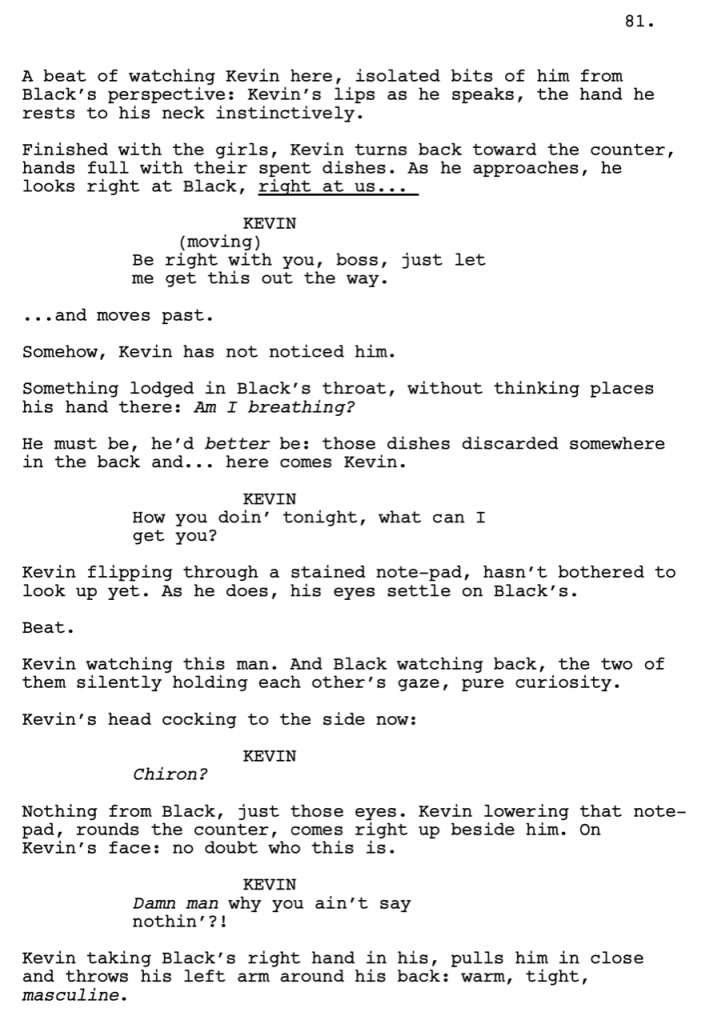
Barry Jenkins delivers this beautiful scene in a way that only he can. An unrequited love rekindled at first sight. We see Kevin through Chiron/Black’s point of view — what parts of his body Black focuses on. When Kevin walks by and makes eye contact with the audience, it puts us in that booth. We’re experiencing this from his perspective.
Jenkins doesn’t flat out say that Black is nervous. He writes, “something lodged in Black’s throat, without thinking places his hand there: Am I breathing?”
He uses italics to highlight a quick internal reflection, as if a thought passing as dialogue. When Kevin returns and they make eye contact, that lingering beat suspends time for Black, and thus the audience. The moment of recognition smoothly falls into place and the reader settles into the moment like an awkward hug that feels like home once you settle into it.
As you can see from the examples above, how you convey a character’s emotional state wholly depends on how your writing style hits the page. You don’t have to slow down the flow with exposition or physical descriptions. There are ways to put a character’s thoughts on the page without dictating an actor’s every choice.
Leave room for the other professionals to play in the white space.
